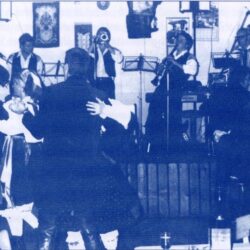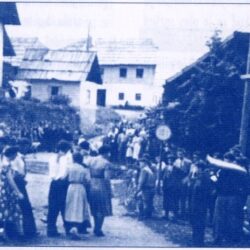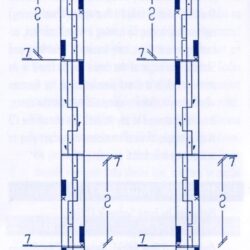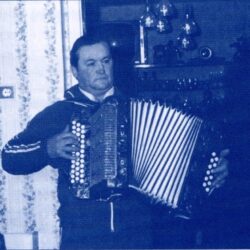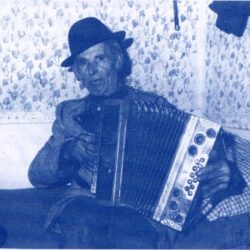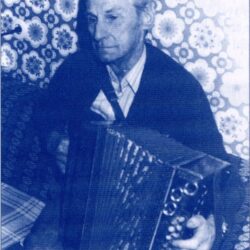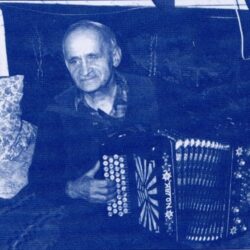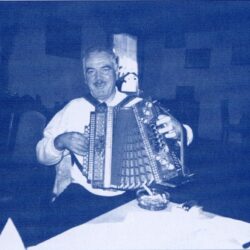Slovenian Folk Dance Music: The Koroška Region

GNI M 39.087
Recorded: Nagelče, 1979
Performed by: Silvester Mohar (1916)
Kačo zvijat or koko vit (Snake coiling) is a group dance where dancers went outdoors, formed a line, held hands and ran, hopped or walked in snake- or spiral-like coils. It is one of the oldest in the dance heritage of all European nations and was mostly danced at weddings or bigger parties. According to the data collected in the Koroška Region, group dance was only present in the eastern part of Podjuna and in Mežiška dolina. It was also called lisičji rej (Fox dance) or jutranjska žlajdra (The morning chain). It was danced to any kind of lively polka which had more parts so that it could be repeated long enough.
GNI M DAT 187/10
Recorded: Žerjav, 2002
Performed by: Slavko Vrabič (1946), Ferdo Piko (1959), Jakob Pisar (1952)
The boys’ dance called kôwo vrtat (Wheel boring) represented boring by turning a wheel and was, according to our data, only known in Zelenbreg pod Strojno. The origin of the dance can be found in its name which is a direct translation of the German “Radbohren”. There is no special tune for the dance; it could be danced to any štajeriš. The one on the audio publication is an example of what musicians nowadays play to accompany folk dance groups.
GNI M 39.671
Recorded: Podroje pri Globasnici, 1980
Performed by: Franc Sadovnik (1914)
Povštertanc (Pillow dance), derived from the German “der Polstertanz”, is a dance game where the dance partner was chosen with a cushion. The dancer who had the cushion chose his dance partner and threw the cushion in front of her (a woman could also choose her partner). They kneeled onto the cushion and kissed, then danced a polka or a waltz. The same dance game is found throughout Europe; that is why it is believed to be a very old part of the heritage. The dance and its name were taken from the German at the same time as the rest of the dances of German origin. It was widely spread among Carinthian Slovenes but not so much in Ziljska dolina. The tune on the audio publication was typical of Podjuna where singing in the first part of the dance game was often heard.
GNI M 41.413
Recorded: Komel, 1983
Performed by: Martin Bolha (1927)
Žesltanc (Chair dance), derived from the German “der Sesseltanz”, is a similar dance game. Here, a dancer sat on a chair and the others approached him/her one by one. The sitting dancer chose a partner and then, the same as with povštertanc, they danced a polka or a waltz. Music was always different; when the dancer was choosing the partner, musicians played a three-beat tune (waltz or štajeriš), whereas during the dancing, polka was played. The chair dance game was spread all over the Koroška Region, except in Ziljska dolina. The musician on the recording always played slow štajeriš for the choosing, and changed to alternating polka and waltz in the second part of the dance game; the recording begins with the second part.
GNI M 37.347
Recorded: Št. Jakob v Rožu, 1977
Performed by: Pauli Antonič (1905)
Another very similar type of dance games where dancers chose their partners was called špegutanc (Mirror dance), derived from the German “der Spiegeltanz”. It was almost the same as the previous one, only here the sitting dancer held a mirror in his hand (the sitting dancer could also be a woman). Other dancers approached him one by one from behind and the sitting dancer chose a partner by looking in the mirror. When he saw a dancer he did not want to dance with, he dismissed her by ‘wiping her off the mirror’ with a handkerchief. When a dancer he liked approached, he nodded to her and they danced a waltz or a polka. Based on the data collected, the dance game was only popular in the eastern part of Podjuna and in Mežiška dolina. In Podjuna, it was also called špigəlrej (another similar expression for the Mirror dance). Musicians played different tunes but they usually alternated three-beat with two-beat ones.
GNI M DAT 211/24
Recorded: Prevalje, 2002
Performed by: Slavko Vrabič (1946)
Dance games with an odd number of dancers were especially popular. It was usually women who stood in a queue, and men (there was one too many) circled around them. On the agreed sign, the men took hold of the nearest woman and started to polka dance. The one left without a partner had to dance with a broom or got a similar forfeit. Sometimes, men and women switched roles. The game was mostly played in Mežiška dolina, less in Podjuna. It was called lisičji raj (Fox dance) or lisičji rep (Fox’s brush). As with other similar dance games, the musicians played different štajeriš tunes or waltzes during the choosing, and different polkas for couples to dance to.
GNI M 38.878
Recorded: Žabnica pri Slovenjem Plajberku, 1979
Performed by: Pavel Lausseger (1911)
In another variant of dance games with an odd number of dancers, a woman with a broom mingled with the dancing couples. Suddenly, she threw it on the floor or knocked on the floor with the broomstick, and all the women had to find another partner. New couples started dancing again, and the slowest female was left with the broom. The dance lasted for as long as the dancers wished; it was also possible to have an odd number of male dancers. The game was very popular in Mežiška dolina, Podjuna and in parts of Rož; in fact, in most places it is still very much alive. The name of the dance is ples z metlo (Broom dance), or opipani rej or raj (Pulling dance) because the women literally “pulled” the male dancers or competed against each other to get a dancing partner. They danced to different tunes, usually to polka or march, sometimes even to waltz.
GNI M DAT 211/11
Recorded: Prevalje, 2002
Performed by: Slavko Vrabič (1946)
Dances of three are variants of trio or triolet, shorter forms of the contredance, and štajeriš. Only štajeriš of three was danced among Carinthian Slovenes, most often at weddings in Mežiška dolina and in Podjuna. Camar, the conductor of wedding celebrations, first danced a štajeriš with the best man’s wife. He then asked her with a special alpine dance quatrain to fetch him the bride. The three of them then danced a štajeriš together (štajeriš of three). Musicians usually played the štajeriš you can hear on the audio publication, sometimes they used another tune.
GNI M 37.630
Recorded: Blače, 1977
Performed by locals after štehvanje
Prvi rej (First dance) is still danced in Ziljska dolina, usually on patron saint’s day after štehvanje (a boy’s competitive game on horses). In Zilja, people called it u pərbə. Where štehvanje is not known, people just dance u pərbə. It consists of two parts: first, couples walk in circle and sing a stanza of the song, then they dance to the tune played by musicians. The singing and dancing alternate until the song is finished. The dance we know today is calm and simple; the steps are similar to the basic form of foxtrot. In the first half of the 19th century, people danced it in a lively manner, and they called it visoki rej (High dance). The lively form started dying out in the second half of the 19th century and was replaced by a calmer dance. As it was always the first to be danced after patron saint’s day festivities, it was called prvi rej (First dance). The original name has long been forgotten among the people in Zilja. The recording on the audio publication was made on patron saint’s day after štehvanje.
GNI M 37.882
Recorded: Brnica, 1977
Performed by: Jurij Mikič (1925)
After prvi rej, musicians play a few polkas and waltzes, and after that rajevci and rajevke (the dancers) go to gostilna (the local pub) where the celebration continues. On the audio publication, you can hear a polka, popular for this occasion.
GNI M 41.446
Recorded: Belšak, 1983
Sung by: Lekš Kert (1910)
At the time of the original visoki rej, a new dance was becoming more and more popular. It was called štajerski ples (Styrian dance), which is the former name of štajeriš. It became one of the most popular dances and remained alive until the 1970’s. Like visoki rej, štajeriš too was a two-part dance with alternating singing and dancing. The form was preserved the longest by Carinthian Slovenes who always performed it at weddings in Rož, Podjuna and in Mežiška dolina. For them, two dance events had special importance: the first dance before the beginning of the wedding feast or right after the first course, and the taking down of the bride’s garland. They were both conducted by the camar (the conductor of wedding celebrations) and his female counterpart, called družička or teta (bridesmaid) who sang and danced alternatingly. A few wedding alpine dance quatrains for the first wedding dance are also included in this audio publication. They were recorded when an informant was explaining the wedding customs, that is why the instrumental part is missing.
GNI M 39.106
Recorded: Nagelče, 1979
Performed by: Silvester Mohar (1916)
The first dance round at weddings always ended with a polka. Namely, when štajeriš was dying out, only the most important wedding couples (who had to learn the štajeriš for this occasion) and some older people who still remembered it could dance it. When polka started playing, all the wedding guests could join.
GNI M DAT 187/16
Recorded: Žerjav, 2002
Performed by: Slavko Vrabič (1946), Ferdo Piko (1959), Jakob Pisar (1952)
The form of štajeriš in the Koroška Region was simple. The male held his partner’s hand and lifted it over his head. The female turned around her partner’s arm, first right, then left, or her partner turned. Another possibility was for the dancers to hold hands above their heads and turn at the same time or alternatingly. They could also cross hands and turn. More complicated figures were rare. In some places, the dance was lively, in others calm with swinging steps. This was especially true when the dance played a ceremonial role in Mežiška dolina. The tune on the audio publication comes from Šentanel nad Prevaljami, where it was performed by a folk dance group’s musicians.
GNI M 24.152
Recorded: Dob pri Pliberku, 1959 (Recorded by dr. France Cigan)
Sung by: Kanaufova
Ovsetni štajeriš s petjem poskočnic (Wedding dance štajeriš with alpine dance quatrains). The taking down of the bride’s garland is a ceremony, known throughout the Koroška Region. The entire ceremony was preserved the longest in Mežiška dolina and in the eastern part of Podjuna. It depended solely on how well the camar and the družička prepared for the ceremony, and how many alpine dance quatrains they knew. It was called krenc dow rajat (the taking down of the bride’s garland) and was a singing dialogue between the camar and the družička while the bride and the groom listened. Between the quatrains, both couples danced štajeriš. During the ceremony, the camar and the bridegroom took off their hats and handed them over to the družička and the bride. They took the hats and put their garlands over them, and after long persuasion, they put the hats with the garlands back on the men’s heads. A short polka followed, later the camar and the družička sang a few more opportune quatrains, after which wedding guests started to take leave. You can hear a few quatrains on the audio publication which were recorded at a reconstruction of the ceremony when former camar and družička showed the researchers the dances and the accompanying songs.
GNI M DAT 187/17
Recorded: Žerjav, 2002
Performed by: Slavko Vrabič (1946), Ferdo Piko (1959), Jakob Pisar (1952)
Majpajerš is one of the variants of the German dance called “Neubayrischer”. According to the data collected, the variants were spread all over the Koroška Region but they were not well preserved, so we only have a full record of the ones from the eastern fringe of Podjuna and from Zelenbreg nad Mežiško dolino. The variants we have come across so far kept the original name, although slightly modified, and the original form with a typical pause in the tune’s third and fourth, and seventh and eighth measures. The pause was filled by dancers who stamped their feet or clapped hands. On the audio publication you can hear a later instrumental adaptation of the tune, originally sung by Angela Ranc from Zelenbreg when she showed our researchers the dance steps.
GNI M 38.875
Recorded: Žabnica pri Slovenjem Plajberku, 1979
Performed by: Pavel Lausseger (1911)
Zibenšrit (Seven steps dance) has a very interesting form of seven steps and is one of the oldest couple dances. It soon spread among Carinthian Slovenes from their German neighbours. The data shows it was known throughout Ziljska dolina and Mežiška dolina. However, its full form was rarely preserved, that is why we believe it never became an integral part of their tradition. The variants kept the original form, tune and name, the latter usually slightly modified (zimšrit, simšrit, sinšrit).
GNI M DAT 211/29
Recorded: Prevalje, 2002
Performed by: Slavko Vrabič (1946)
The “Neukatolisch” dance was popular throughout German-speaking environment and was adopted by Slovenes as well. But the variants recorded in Spodnji Rož and Mežiška dolina suggest it was not very popular. It was more often danced in the Gorenjska Region (the alpine region in the northwest) and in the Dolenjska Region (the lowlands in the south) where it was brought to from Tyrol. Choreographically, it is similar to zibenšrit; they both take over the whole dance-floor. In Sela pri Borovljah the original name was kept, whereas in Zelenbreg it was called švajcerpolka (Swiss polka) or lizipolka.
GNI M 37.343
Recorded: Št. Jakob v Rožu, 1977
Performed by: Pauli Antonič (1905)
Mazurka, a dance of Polish origin, moved from the towns’ dance-floors to the countryside in the second half of the 19th century where it changed a bit and, like elsewhere, remained an integral part of the Carinthian Slovenes’ dance repertoire. It was danced up to the first half of the 20th century, but musicians and the people remembered it even longer. It was danced in a simple manner, moving back and forth in small hop-steps or turned right and left. The dance usually kept its original name; in some places it was modified to madzurka, mazolka or mazulka; in Sela pri Borovljah it was even called potrkana (The stamping mazurka). The mazurka was danced to different tunes, which were usually similar to štajeriš; that is why the musicians often mistook one for the other.
GNI M 41.343
Recorded: Led, 1983
Performed by: Franc Klemenjak (1908)
Malender developed from “Varsovienne”, a type of mazurka, and was only known in the Koroška Region (Rož, Podjuna, Mežiška dolina), and in the neighbouring north-eastern part of the Štajerska Region (eastern Slovenia), nowhere else in the country. The first records of it are from the beginning of the 20th century which implies it must have been danced at least two decades before that. All variants of the tune are similar to gorenjski mrzulin (a dance from the neighbouring Gorenjska Region), whereas the dance form is a mélange of mrzulin, waltz and zibenšrit. The origin of the dance’s name is unclear; perhaps two words blended (mazur and lender). Two other very similar names for the same dance were also used; malendra and malendrca.
GNI M 37.888
Recorded: Brnica, 1977
Performed by: Jurij Mikič (1925)
Rašpla is a social dance of Mexican origin which came to Europe between the two world wars and spread to the countryside rapidly. In Slovenia, it became a real folk dance with a lot of variants after the Second World War. Its form was similar to older dances where dancers jumped with both legs simultaneously, which was one of the reasons why it became extremely popular. However, it was not danced much among Carinthian Slovenes as we only have a description of the dance and the accompanying tune from Brnica where the dance was called raspa. It is one of the two-part dances in which the first part consists of different dance figures and the second part is always polka or vrtenica.
GNI M DAT 211/21
Recorded: Prevalje, 2002
Performed by: Slavko Vrabič (1946)
Pastirica (Shepardess) is also one of the older dances where dancers jump with both legs simultaneously, only here the dancers did not jump but touched the ground with the heel of the active foot. In the Koroška Region, the dance was not widely known or had long been forgotten as it was only documented in Sela pri Borovljah, Obirsko and in Mežiška dolina. It originates from the German “Hiatamadl” from western Austria where Slovenians adopted it from and translated its name.
GNI M 41.342
Recorded: Led, 1983
Performed by: Franc Klemenjak (1908)
Just like rašpla and pastirica, šuštarpolka (Shoemaker’s polka) is a two-part dance, too. The dancers kneeled and imitated the shoemaker’s job in the first part (such as the making of shoemaker’s thread, sewing with shoemaker’s thread or pounding wooden nails), and danced polka or vrtenica in the second. The data shows that šuštarpolka was only known in a few places in Rož, Podjuna and in Mežiška dolina. The records of it are relatively rare as it had long been forgotten; in most cases, people could only remember its name. The recording on the audio publication shows how difficult it was for the musician to remember the forgotten tune. He was also unsure whether the first part should be repeated or not.
GNI M DAT 187/23
Recorded: Žerjav, 15.3.2002
Performed by: Slavko Vrabič (1946), Ferdo Piko (1959), Jakob Pisar (1952)
Vevrca (Wooing dance) is similar to dances like “Jaz sem sirota” (I am an orphan) from Bela Krajina or “Po zelenoj trati” (Over the green grass) from Prekmurje, except that the rhythm is three-beat. It probably originates from the “Rheinländer” type which was known by the German-speaking Carinthians. Vevrca was popular in the same places as pastirica (Sela pri Borovljah, Obirsko, Mežiška dolina); its emergence could therefore be a consequence of folklorism.
GNI M 39.101
Recorded: Nagelče, 1979
Performed by: Silvester Mohar (1916)
Polka spread among Carinthian Slovenes as early as in the second half of the 19th century. Together with the waltz, they are the only two folk dances still danced today. As in other parts of Slovenia, its original form with a hop-step has mostly been abandoned; couples now dance it in a simple three-step manner (with change steps) by turning right or left on the spot or moving along the circle. It is unique for Podjuna that couples predominantly turn left. The different polkas from this audio publication suggest that the modification of the dance was influenced by musicians as well; namely, they sometimes played so fast that dancers were forced to leave out the hop-step.
GNI M 38.872
Recorded: Žabnica pri Slovenjem Plajberku, 1979
Performed by: Pavel Lausseger (1911)
Instead of polka which requires more dancing skills, Slovenes in the Koroška Region nowadays prefer vrtenica (Spinning dance), the two-step spinning which can either be slow or fast. Vrtenica is sometimes called polka, in spite of the different form; the reason being that it is danced to the same tune. More commonly, however, it is called cvajšrit (Two-step dance) or ajnšrit (One-step dance). The recorded polka consists, like many others, of two parts which is stressed even more with the musician’s use of different styles of bass accompaniment.
GNI M 38.874
Recorded: Žabnica pri Slovenjem Plajberku, 1979
Performed by: Pavel Lausseger (1911)
When dancing vrtenica, couples usually spin in simple steps; in the past, however, these steps were combined with small leaps which made it seem like the whole body was shaking. Such vrtenica was called céprle, cŹprl, or ájnšrit (e.g. in Žabnica pri Slovenjem Plajberku). It was danced to a typical eight-measure tune with a special ending with three stamps. It is no longer danced in the Koroška Region.
GNI M 41.402
Recorded: Komel, 1983
Performed by: Martin Bolha (1927)
Valček (waltz) came to the region as early as in the first half of the 19th century and soon became the most popular dance next to polka, a fact which has not changed in the countryside until today. Apart form the simple waltz, springing waltz was danced until the Second World War or even longer. Characteristic of it was a high spring in each measure, which gave the waltz its name: ta vəsuočə bolcar or ta visoki bolcar (The high waltz). Next to polka, waltz had prime position in the musicians’ repertoire. The tune on the audio publication was played by a single musician on three instruments simultaneously: accordion, drum and kazoo.
GNI M 39.088
Recorded: Nagelče, 1979
Performed by: Silvester Mohar (1916)
The most widely spread form of waltz is the three-step spinning in right and left on the spot or along the circle. Less skilled dancers dance it with only one step and draw the active foot in the second quarter-note. In Podjuna and in Mežiška dolina, another form of the waltz was popular; it was called ta nizki bolcar (The low waltz) and it was similar to the one-step waltz, only here dancers made a deep kneel in the third quarter-note. The tune for such a waltz had to be slower.
GNI M DAT 211/17
Recorded: Prevalje, 2002
Performed by: Slavko Vrabič (1946)
The Austrian Bauernwalzer is a later variant of the Neubayrischer dance. Its origin is unknown. It spread to Slovenia between both world wars under the name of kmečki valček (Barn dance). The spreading was partly influenced by schools where the folk song Ob bistrem potoku je mlin (There is a mill next to a clear stream) was taught. The dance got its name from that song; mlinček (The little mill). There is not much data in the Koroška Region about it; according to the records it was only danced in Sela pri Borovljah and in some places in Mežiška dolina. Due to its relative youth, the variants have no differences in form.
GNI M 83.956
Recorded: Sele pri Borovljah, 1979
Sung by: Mira Oraže (1942)
Špacir or špacirbolcar (Walk dance) is a two-part dance of German origin in which the two-part, two-beat walk alternated with the waltz. In the Koroška Region, it was danced in Rož, Podjuna and in Mežiška dolina, but it fell into oblivion before the Second World War. It was brought back to life by the folk dance group from Sela pri Borovljah. The dancers follow the pattern of a two-stanza paraphrase which they sing during the dance. The recording on the audio publication was made when a singer was talking about the dance; she was given the information about it by an older musician.
GNI M 38.974
Recorded: Sele pri Borovljah, 1979
Performed by: Valentin Magek (1901)
The old musician was Valentin Magek who could still remember and play špacirvalcer (Walk waltz) the way it used to be danced. In the first part, couples held hands and walked in circle, then they waltzed. According to the melody of the first part, it can be assumed the song only had one stanza originally; because of its drinking contents which does not belong to the first one, the second stanza must have been added later. But it was the later two-stanza form that was used for the reconstruction of the dance by the folk dance group from Sela.
GNI M 37.339
Recorded: Št. Jakob v Rožu, 1977
Performed by: Pauli Antonič (1905)
Marši (Marches) were an important part of the musicians’ repertoire and were a must at weddings. The march accompanied wedding guests on their way to the bride, to the wedding ceremony, and out of the church. They were also played for dance since polka or the even easier vrtenica could be danced to them. Marches have retained the important role at weddings; musicians play them to accompany wedding guests on their way home.
Mirko Ramovš: Slovenian Folk Dance Music – the Koroška Region
The audio material for the first audio publication from the series called Slovenske ljudske plesne viže (Slovene Folk Dance Music) was recorded in the Koroška Region (the alpine region in the north). A part of it was compiled in the Slovene community in Austrian Carinthia (in the areas of Ziljska dolina, Rož, Podjuna) and the other one in Slovenia (in the area of Mežiška dolina with Strojno). The recordings illustrate the dances from the same region, published in the book Polka je ukazana: plesno izročilo na Slovenskem – Koroška in zahodna Štajerska (The Polka is Ordered: Dance Heritage in Slovenia – the Koroška Region and the Western Štajerska Region) (Ramovš, 2000). The word “illustrate” was used because the recordings on the audio publication are mostly not the same as the note records in the book but their variants. The reasons why the authors of the audio publication have decided to publish the variants are threefold: many recordings of the tunes published in the book could not be used due to their poor technical quality; some dance tunes have only been preserved in written records; and the authors of the audio publication wished to present the musical image of folk dances, preserved by several musicians whose recordings are stored in the sound archives of the Institute of Ethnomusicology ZRC SAZU.
Most of the recordings were made between 1977 and 1983 when an ethnomusicological survey of the Slovene community in Austrian Carinthia was carried out by the Institute of Ethnomusicology. The rest of the pieces are recent recordings of musicians who could remember the dance tunes from their childhood and could still play them, or who learned to play them from written sources and now accompany folk dance groups.
Most of the musicians the Institute’s staff visited had not played the old dance tunes for a long time and had to recollect them at the time of recording. Their performance is therefore not always perfect which does not, however, diminish the documentary value of the recordings in any way. Before publishing some work was needed on a few documentary recordings; either because the musicians did not play the tune to be danced to but only as an illustration (here, duplication was needed), or because the musicians made a lot of mistakes or were only trying to remember the tune (these tunes needed some editing). Our aim was to publish the dance tune in the form the musicians remembered but could not perform in full on the day of recording. There were fewer problems with polkas, waltzes and marches, simply because the musicians’ repertoire for dance parties and weddings consisted mostly of them, and in the Institute’s archives store plenty of this material.
A substantial amount of data about bigger ensembles in the past was collected as well. Unfortunately, they had ceased to exist at the time of research so it was impossible to record them. That is why the audio publication can only contain examples of what the ensembles used to play, performed by a single musician on diatonic accordion and some recent recordings of a trio which accompanies a folk dance group and tries to imitate the former ensembles.
Tunes for most of the dances characteristic of Carinthian Slovenes are included in the audio publication. As far as form and music are concerned, their dance heritage is similar to other Slovene regions because it has developed in a similar way. From reasons unknown, the authentic dances of Carinthian Slovenes except for visoki or prvi rej (High or first dance) and a few others started dying out. Germans were the nearest neighbours of Carinthian Slovenes and their dances slowly replaced the original ones, probably as early as at the end of the 17th century. Later, they also spread south to other Slovene regions. However, in the 19th century, German dances were brought to Slovenia mostly by artisans who went to Austria, especially to Tyrol, for vocational training. The new dances were adapted by Slovenes according to their movement ability and got a new look, but their origin still can be found in the tunes and names.
